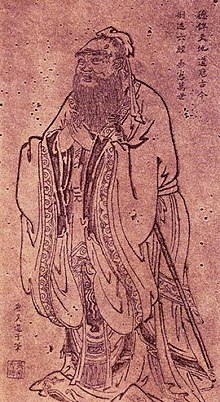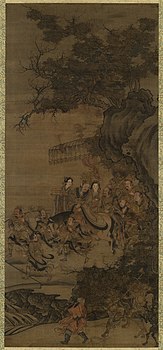art.wikisort.org - Artist
Wu Daozi (c. 685–758 CE[1] or c. 689–759 CE), also known as Daoxuan and Wu Tao Tzu, was a Chinese painter of the Tang dynasty. The British art historian Michael Sullivan considers him one of "the masters of the seventh century,"[1] Some of his works survive; many, mostly murals, have been lost.
This article uses bare URLs, which are uninformative and vulnerable to link rot. (September 2022) |

| Wu Daozi | |||||||||
|---|---|---|---|---|---|---|---|---|---|
| Traditional Chinese | 吳道子 | ||||||||
| Simplified Chinese | 吴道子 | ||||||||
| |||||||||
| Daoxuan | |||||||||
| Chinese | 道玄 | ||||||||
| |||||||||
Wu lost his father at an early age and lived in poverty. He learned calligraphy from Zhang Xu and He Zhizhang, before specialising in painting. He pioneered realistic techniques, the formal establishment of brushwork, and landscape painting. He painted figures with round strokes so as to show their flowing clothes.
Works

He traveled widely and created murals in Buddhist and Daoist temples. Wu also drew mountains, rivers, flowers, birds. No authentic originals are extant, though some exist in later copies or stone carvings.[2] Wu's famous painting of Confucius was preserved through being copied in a stone engraving.
Legends
Numerous legends gathered around Wu Daozi, often concerning commissions by Emperor Xuanzong.
In one, Emperor Xuanzong called him to paint a wall of his palace. He painted a wall mural displaying a rich nature-scene set in a valley, containing a stunning array of flora and fauna and including a cave at the foot of a mountain. The story goes that he informed the emperor that it's not just what the emperor is able to see, Wu Daozi has made this painting in such a way, that a spirit dwells in the cave. Next, he clapped his hands and entered the cave, inviting the emperor to follow. The painter entered the cave but the entrance closed behind him and, before the astonished emperor could move or utter a word, the painting vanished from the wall. This story depicts the spirituality of art.[3] The contemporary Swedish writer Sven Lindqvist meditates on this legend and the challenge that it poses to modern aesthetics in his book, The Myth of Wu Tao-Tzu.[4]
Another legend states that Emperor Xuanzong sent Wu Daozi to Sichuan to study the green waters of the Jialing River in order to complete a mural of its entire course.[5] Supposedly, Wu returned without sketches and rapidly painted the entire river from memory, completing the 300-li account[5] within a single day.[6] It is sometimes added that his technique was foiled by Li Sixun, who accompanied him and followed the traditional practice of working slowly from numerous prepared sketches.[7] To the extent that it is grounded in a real event, however, it probably only reflects Wu's speed of execution and not a lack of reliance on sketches.[8]
Another has it that a painter found one of the last surviving murals of Wu Daozi and learned to imitate the style. He then destroyed the wall, possibly by pushing it into a river, to ensure that no one else could learn the same secrets.
Legacy
The Presentation of Buddha was featured in 2004-5 television presentations in China.[9][10]
- Black and white reproduction of a portrait of Sakyamuni (the Buddha), attributed to Wu Daozi, published in 12th edition of Encyclopædia Britannica (1911)
- Daoist deity of Earth, attributed to Wu Daozi
- Daoist deity of Heaven
See also
- Chinese mythology
- Zhou Fang, contemporary Tang dynasty painter
References
- Chinese Landscape Painting: The Sui and T'ang Dynasties. (Berkeley: University of California press, 1980. ISBN 0520035585), pp. 50-52.
- James Cahill. An Index of Early Chinese Painters and Paintings: T'ang, Sung, and Yüan. (Berkeley: University of California Press, 1980. ISBN 0520035763), pp. 21-22.
- A version of this story appears in Herbert Allen Giles. An Introduction to the History of Chinese Pictorial Art. (London: Quaritch, 2d ed., 1918), pp. 47-48.
- Sven Lindqvist, translated by Joan Tate. The Myth of Wu Tao-Tzu. (1967; rpr. London: Granta, 2012. ISBN 9781847085221).
- 《中国文化历史故事》 [Zhongguo Wenhua Gushi Congshu], pp. 232–3. (in English)
- Strassberg, Richard E. (ed.), Inscribed Landscapes: Travel Writing from Imperial China, p. 35.
- Van Briessen, Fritz (1964), The Way of the Brush: Painting Techniques of China and Japan, p. 52.
- Kao Yu-kung, "Chinese Lyric Aesthetics", Words and Images: Chinese Poetry, Calligraphy, and Painting, pp. 84–5.
- "画圣——吴道子".
- http://www.cctv.com/art/20040412/101225.shtml
На других языках
- [en] Wu Daozi
[es] Wu Daozi
Wu Tao-tzu o Wu Daozi (Chino simplificado: 吴道子, chino tradicional: 吳道子, pinyin: Wú Dàozǐ, Wade-Giles: Wu Tao-tzu)(680-740) artista chino de la dinastía Tang.[fr] Wu Daozi
Wu Tao-tzu ou Wu Daozi (Sinogramme simplifié: 吴道子, sinogrammes traditionnels: 吳道子, pinyin: Wú Dàozǐ, EFEO : Wou Taotseu) (680-740) était un artiste chinois actif sous la dynastie Tang. Il a renommé plus tard Dao Xuan (pinyin: Dàoxuán), l’histoire de la peinture s’appelle "Wu Sheng" (pinyin: Wú shēng)[it] Wu Daozi
Wu Daozi[1] (吳道子T, 吴道子S, Wú DàozǐP; Yuzhou , Xuchang, 680 c. – 760 circa) è stato un pittore cinese d'epoca Tang. Michael Sullivan lo considera "uno dei maestri del secolo VII".[2] Delle sue opere, pochissime sono giunte a noi, ma esistono diverse copie più tarde eseguite con inchiostro su pietra.[3] Dalla tradizione, è considerato l'iniziatore della pittura di paesaggio.[4][ru] У Даоцзы
У Даоцзы (кит. 吴道子, 680—740) — китайский художник династии Тан. Старая китайская традиция причисляет У Даоцзы к четырём отцам-основателям китайской живописи; трое остальных — это Гу Кайчжи (344—406), Лу Таньвэй (работал в 450-х — 490-х годах), и Чжан Сэнъяо (ок. 500 — ок. 550).Другой контент может иметь иную лицензию. Перед использованием материалов сайта WikiSort.org внимательно изучите правила лицензирования конкретных элементов наполнения сайта.
WikiSort.org - проект по пересортировке и дополнению контента Википедии



